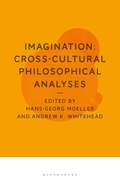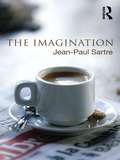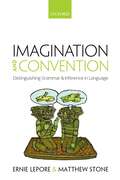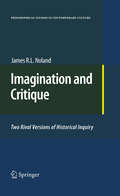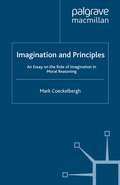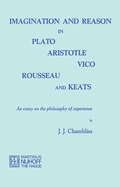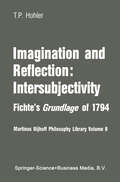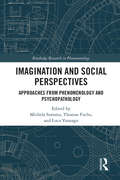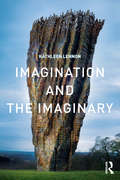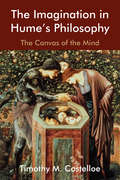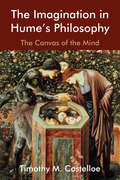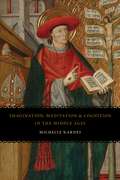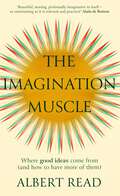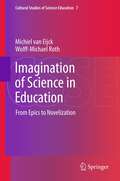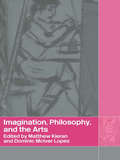- Table View
- List View
Imagination: Cross-Cultural Philosophical Analyses
by Hans-Georg Moeller Andrew WhiteheadImagination: Cross-Cultural Philosophical Analyses is a rare intercultural inquiry into the conceptions and functions of the imagination in contemporary philosophy. Divided into East Asian, comparative, and post-comparative approaches, it brings together a leading team of philosophers to explore the concepts of the illusory and illusions, the development of fantastic narratives and metaphors, and the use of images and allegories across a broad range of traditions. Chapters discuss how imagination has been interpreted by thinkers such as Zhuangzi, Plato, Confucius, Heidegger, and Nietzsche. By drawing on sources including Buddhist aesthetics, Daoism, and analytic philosophy of mind, this cross-cultural collection shows how the imagination can be an indispensable tool for the comparative philosopher, opening up new possibilities for intercultural dialogue and critical engagement.
Imagination: Cross-Cultural Philosophical Analyses
by Professor Hans-Georg Moeller Andrew WhiteheadImagination: Cross-Cultural Philosophical Analyses is a rare intercultural inquiry into the conceptions and functions of the imagination in contemporary philosophy. Divided into East Asian, comparative, and post-comparative approaches, it brings together a leading team of philosophers to explore the concepts of the illusory and illusions, the development of fantastic narratives and metaphors, and the use of images and allegories across a broad range of traditions. Chapters discuss how imagination has been interpreted by thinkers such as Zhuangzi, Plato, Confucius, Heidegger, and Nietzsche. By drawing on sources including Buddhist aesthetics, Daoism, and analytic philosophy of mind, this cross-cultural collection shows how the imagination can be an indispensable tool for the comparative philosopher, opening up new possibilities for intercultural dialogue and critical engagement.
The Imagination
by Jean-Paul Sartre‘No matter how long I may look at an image, I shall never find anything in it but what I put there. It is in this fact that we find the distinction between an image and a perception.' - Jean-Paul Sartre L’Imagination was published in 1936 when Jean-Paul Sartre was thirty years old. Long out of print, this is the first English translation in many years. The Imagination is Sartre’s first full philosophical work, presenting some of the basic arguments concerning phenomenology, consciousness and intentionality that were to later appear in his master works and be so influential in the course of twentieth-century philosophy. Sartre begins by criticising philosophical theories of the imagination, particularly those of Descartes, Leibniz and Hume, before establishing his central thesis. Imagination does not involve the perception of ‘mental images’ in any literal sense, Sartre argues, yet reveals some of the fundamental capacities of consciousness. He then reviews psychological theories of the imagination, including a fascinating discussion of the work of Henri Bergson. Sartre argues that the ‘classical conception’ is fundamentally flawed because it begins by conceiving of the imagination as being like perception and then seeks, in vain, to re-establish the difference between the two. Sartre concludes with an important chapter on Husserl’s theory of the imagination which, despite sharing the flaws of earlier approaches, signals a new phenomenological way forward in understanding the imagination. The Imagination is essential reading for anyone interested in the philosophy of Jean-Paul Sartre, phenomenology, and the history of twentieth-century philosophy. This new translation includes a helpful historical and philosophical introduction by Kenneth Williford and David Rudrauf. Also included is Maurice Merleau-Ponty’s important review of L’Imagination upon its publication in French in 1936. Translated by Kenneth Williford and David Rudrauf.
The Imagination
by Jean-Paul Sartre‘No matter how long I may look at an image, I shall never find anything in it but what I put there. It is in this fact that we find the distinction between an image and a perception.' - Jean-Paul Sartre L’Imagination was published in 1936 when Jean-Paul Sartre was thirty years old. Long out of print, this is the first English translation in many years. The Imagination is Sartre’s first full philosophical work, presenting some of the basic arguments concerning phenomenology, consciousness and intentionality that were to later appear in his master works and be so influential in the course of twentieth-century philosophy. Sartre begins by criticising philosophical theories of the imagination, particularly those of Descartes, Leibniz and Hume, before establishing his central thesis. Imagination does not involve the perception of ‘mental images’ in any literal sense, Sartre argues, yet reveals some of the fundamental capacities of consciousness. He then reviews psychological theories of the imagination, including a fascinating discussion of the work of Henri Bergson. Sartre argues that the ‘classical conception’ is fundamentally flawed because it begins by conceiving of the imagination as being like perception and then seeks, in vain, to re-establish the difference between the two. Sartre concludes with an important chapter on Husserl’s theory of the imagination which, despite sharing the flaws of earlier approaches, signals a new phenomenological way forward in understanding the imagination. The Imagination is essential reading for anyone interested in the philosophy of Jean-Paul Sartre, phenomenology, and the history of twentieth-century philosophy. This new translation includes a helpful historical and philosophical introduction by Kenneth Williford and David Rudrauf. Also included is Maurice Merleau-Ponty’s important review of L’Imagination upon its publication in French in 1936. Translated by Kenneth Williford and David Rudrauf.
Imagination and Convention: Distinguishing Grammar and Inference in Language
by Ernie Lepore Matthew StoneHow do hearers manage to understand speakers? And how do speakers manage to shape hearers' understanding? Lepore and Stone show that standard views about the workings of semantics and pragmatics are unsatisfactory. They offer a new account of language as a specifically social competence for making our ideas public. They argue that this approach is a good way to target the distinctive mechanisms and problems at play in explaining the human faculty of language. At the same time, this view embraces the diverse dimensions of meaning that linguists have discovered. This is the right way to delimit semantics.
Imagination and Critique: Two Rival Versions of Historical Inquiry (Philosophical Studies in Contemporary Culture #19)
by James R. NolandThis book is most easily described as philosophy of history; however, this descr- tion may be a little misleading. Truly, this is a work of applied philosophy that was originally conceived not in a philosophy seminar but in a school of public policy. As a philosopher learning about the study of public policy formation, I was f- quently struck by what I perceived to be two very different sets of assumptions and methods at work. I found these assumptions and methods to be mutually exclusive conceptually, but they were often employed simultaneously. On the one hand, it was often accepted as given when studying past policy changes and political events that history is shaped by impersonal forces, that p- ple’s actions can, and ought only to be understood as manifestations of their own material interests, and that individuals are to be identi?ed as representatives of their respective demographic categories. Thus, for example, the events in question were explained in terms of the race or class of the various parties. When such an approach was challenged with an appeal to the actual arguments and stated rationales of the participants of the historical moment in question, this was taken to be an option that might be employed either in conjunction with the former method or as an alter- tive. Which method one chose to emphasize or employ exclusively seemed more a function of inclination or intuition than rational adjudication.
Imagination and Principles: An Essay on the Role of Imagination in Moral Reasoning
by M. CoeckelberghWhat does it mean to say that imagination plays a role in moral reasoning, and what are the theoretical and practical implications? Engaging with three traditions in moral theory and confronting them with three contexts of moral practice, this book comprehensively explores these questions and the relation between imagination and principles.
Imagination and Reason in Plato, Aristotle, Vico, Rousseau and Keats: An Essay on the Philosophy of Experience
by J.J. ChamblissThe present essay grew out of an inte:rest in exploring the relationship be tween "imagination" and "reason" in the history of naturalistic thinking. The essay tries to show something of the spirit of naturalism coming to terms with the place of imagination and reason in knowing, making, and doing as activities of human experience. This spirit is discussed by taking as its point of departure the thinking of five writers: Plato, Aristotle, Giam battista Vieo, Jean-Jacques Rousseau, and John Keats. Plato and Aristotle are considered as spokesmen of reason in a world which appeared to be dominated by non-reason. They found it essential for human beings to try to learn how to distinguish between the work of imagin ation and the work of reason. In trying to make such a distinction, it becomes clear that imagination has its legitimate place, along with reason, in human activity. Or we might say that determining the place which each has is a continuing problem when human beings take seriously what is involved in shaping mind and character.
Imagination and Reflection: Fichte’s Grundlage of 1794 (Martinus Nijhoff Philosophy Library #8)
by Thomas P. HohlerThis work resulted from my interests in several flDldam ental issues of contemporary phenomenology. Originally, their focal point was 1) the role and importance of the subject in philosophical activity and 2) the subject's finitude. To gain a perspective on these issues, a possible approach seemed to lie in the direction of the transcendental imagination and its relation to tim e. This focus on the imagination, of course, led to Fichte's egological philosophy that explicitly centers on the imagination. Here both issues are raised together. The reader of the Fichtean texts cannot for long hesitate to pose the question of intersubjectivity. These three issues-imagination, reflection, and inter subjectivity-formed the basis of the present work. Since such a work could never be completed if it were not for those num erot5 discussions and friendly conversation with friends and colleagues with whom philosophy is always alive, I wish to acknowledge my gratitude specifically to the following people: Professor Andre Schuwer, of Duquesne University, for his encouragement, critical reading of the work, and his comments that have greatly aided me in the writing of the present work; Professor John Sallis, Chairman of the Philosophy Department of Duquesne University, whose interest in Fichte provided invaluable insights and approaches to the issues; Professor Paul Ricoeur, University of Paris and University of Chicago, whose reading and encouragement greatly helped in the work's publication; Professor Samuel Ijsseling, University of Leuven, who introduced me to Martinus Nijhoff Publishers; Professor G. A.
Imagination and Social Perspectives: Approaches from Phenomenology and Psychopathology (Routledge Research in Phenomenology)
by Michela Summa Thomas Fuchs Luca VanzagoOur experience of other individuals as minded beings goes hand in hand with the awareness that they have a unique epistemic and emotional perspective on the experienced objects and situations. The same object can be seen from many different points of view, an event can awaken different emotional reactions in different individuals, and our position-takings can in part be mediated by our belonging to some social or cultural groups. All these phenomena can be described by referring to the metaphor of perspective. Assuming that there are different, and irreducible, perspectives we can take on the experienced world, and on others as experiencing the same world, the phenomenon of mutual understanding can consistently be understood in terms of perspectival flexibility. This edited volume investigates the different processes in which perspectival flexibility occurs in social life and particularly focuses on the constitutive role of imagination in such processes. It includes original works in philosophy and psychopathology showing how perspectival flexibility and social cognition are grounded on the interplay of direct perception and imagination.
Imagination and Social Perspectives: Approaches from Phenomenology and Psychopathology (Routledge Research in Phenomenology)
by Michela Summa Thomas Fuchs Luca VanzagoOur experience of other individuals as minded beings goes hand in hand with the awareness that they have a unique epistemic and emotional perspective on the experienced objects and situations. The same object can be seen from many different points of view, an event can awaken different emotional reactions in different individuals, and our position-takings can in part be mediated by our belonging to some social or cultural groups. All these phenomena can be described by referring to the metaphor of perspective. Assuming that there are different, and irreducible, perspectives we can take on the experienced world, and on others as experiencing the same world, the phenomenon of mutual understanding can consistently be understood in terms of perspectival flexibility. This edited volume investigates the different processes in which perspectival flexibility occurs in social life and particularly focuses on the constitutive role of imagination in such processes. It includes original works in philosophy and psychopathology showing how perspectival flexibility and social cognition are grounded on the interplay of direct perception and imagination.
Imagination and the Imaginary
by Kathleen LennonThe concept of the imaginary is pervasive within contemporary thought, yet can be a baffling and often controversial term. In Imagination and the Imaginary, Kathleen Lennon explores the links between imagination - regarded as the faculty of creating images or forms - and the imaginary, which links such imagery with affect or emotion and captures the significance which the world carries for us. Beginning with an examination of contrasting theories of imagination proposed by Hume and Kant, Lennon argues that the imaginary is not something in opposition to the real, but the very faculty through which the world is made real to us. She then turns to the vexed relationship between perception and imagination and, drawing on Kant, Merleau-Ponty and Sartre, explores some fundamental questions, such as whether there is a distinction between the perceived and the imagined; the relationship between imagination and creativity; and the role of the body in perception and imagination. Invoking also Spinoza and Coleridge, Lennon argues that, far from being a realm of illusion, the imaginary world is our most direct mode of perception. She then explores the role the imaginary plays in the formation of the self and the social world. A unique feature of the volume is that it compares and contrasts a philosophical tradition of thinking about the imagination - running from Kant and Hume to Strawson and John McDowell - with the work of phenomenological, psychoanalytic, poststructuralist and feminist thinkers such as Merleau-Ponty, Sartre, Lacan, Castoriadis, Irigaray, Gatens and Lloyd. This makes Imagination and the Imaginary essential reading for students and scholars working in phenomenology, philosophy of perception, social theory, cultural studies and aesthetics. Cover Image: Bronze Bowl with Lace, Ursula Von Rydingsvard, 2014. Courtesy the artist, Galerie Lelong and Yorkshire Sculpture Park. Photo Jonty Wilde.
Imagination and the Imaginary
by Kathleen LennonThe concept of the imaginary is pervasive within contemporary thought, yet can be a baffling and often controversial term. In Imagination and the Imaginary, Kathleen Lennon explores the links between imagination - regarded as the faculty of creating images or forms - and the imaginary, which links such imagery with affect or emotion and captures the significance which the world carries for us. Beginning with an examination of contrasting theories of imagination proposed by Hume and Kant, Lennon argues that the imaginary is not something in opposition to the real, but the very faculty through which the world is made real to us. She then turns to the vexed relationship between perception and imagination and, drawing on Kant, Merleau-Ponty and Sartre, explores some fundamental questions, such as whether there is a distinction between the perceived and the imagined; the relationship between imagination and creativity; and the role of the body in perception and imagination. Invoking also Spinoza and Coleridge, Lennon argues that, far from being a realm of illusion, the imaginary world is our most direct mode of perception. She then explores the role the imaginary plays in the formation of the self and the social world. A unique feature of the volume is that it compares and contrasts a philosophical tradition of thinking about the imagination - running from Kant and Hume to Strawson and John McDowell - with the work of phenomenological, psychoanalytic, poststructuralist and feminist thinkers such as Merleau-Ponty, Sartre, Lacan, Castoriadis, Irigaray, Gatens and Lloyd. This makes Imagination and the Imaginary essential reading for students and scholars working in phenomenology, philosophy of perception, social theory, cultural studies and aesthetics. Cover Image: Bronze Bowl with Lace, Ursula Von Rydingsvard, 2014. Courtesy the artist, Galerie Lelong and Yorkshire Sculpture Park. Photo Jonty Wilde.
The Imagination in Hume's Philosophy: The Canvas of the Mind
by Timothy M. CostelloeDefines the cutting-edge of scholarship on ancient Greek history employing methods from social science
The Imagination in Hume's Philosophy: The Canvas of the Mind (Edinburgh Studies In Scottish Philosophy Ser.)
by Timothy M. CostelloeExplores the contemporary significance of Alfred North Whitehead’s 1927 book Symbolism: Its Meaning and Effect
Imagination, Meditation, and Cognition in the Middle Ages
by Michelle KarnesIn Imagination, Meditation, and Cognition in the Middle Ages, Michelle Karnes revises the history of medieval imagination with a detailed analysis of its role in the period’s meditations and theories of cognition. Karnes here understands imagination in its technical, philosophical sense, taking her cue from Bonaventure, the thirteenth-century scholastic theologian and philosopher who provided the first sustained account of how the philosophical imagination could be transformed into a devotional one. Karnes examines Bonaventure’s meditational works, the Meditationes vitae Christi, the Stimulis amoris, Piers Plowman, and Nicholas Love’s Myrrour, among others, and argues that the cognitive importance that imagination enjoyed in scholastic philosophy informed its importance in medieval meditations on the life of Christ. Emphasizing the cognitive significance of both imagination and the meditations that relied on it, she revises a long-standing association of imagination with the Middle Ages. In her account, imagination was not simply an object of suspicion but also a crucial intellectual, spiritual, and literary resource that exercised considerable authority.
Imagination, Meditation, and Cognition in the Middle Ages
by Michelle KarnesIn Imagination, Meditation, and Cognition in the Middle Ages, Michelle Karnes revises the history of medieval imagination with a detailed analysis of its role in the period’s meditations and theories of cognition. Karnes here understands imagination in its technical, philosophical sense, taking her cue from Bonaventure, the thirteenth-century scholastic theologian and philosopher who provided the first sustained account of how the philosophical imagination could be transformed into a devotional one. Karnes examines Bonaventure’s meditational works, the Meditationes vitae Christi, the Stimulis amoris, Piers Plowman, and Nicholas Love’s Myrrour, among others, and argues that the cognitive importance that imagination enjoyed in scholastic philosophy informed its importance in medieval meditations on the life of Christ. Emphasizing the cognitive significance of both imagination and the meditations that relied on it, she revises a long-standing association of imagination with the Middle Ages. In her account, imagination was not simply an object of suspicion but also a crucial intellectual, spiritual, and literary resource that exercised considerable authority.
Imagination, Meditation, and Cognition in the Middle Ages
by Michelle KarnesIn Imagination, Meditation, and Cognition in the Middle Ages, Michelle Karnes revises the history of medieval imagination with a detailed analysis of its role in the period’s meditations and theories of cognition. Karnes here understands imagination in its technical, philosophical sense, taking her cue from Bonaventure, the thirteenth-century scholastic theologian and philosopher who provided the first sustained account of how the philosophical imagination could be transformed into a devotional one. Karnes examines Bonaventure’s meditational works, the Meditationes vitae Christi, the Stimulis amoris, Piers Plowman, and Nicholas Love’s Myrrour, among others, and argues that the cognitive importance that imagination enjoyed in scholastic philosophy informed its importance in medieval meditations on the life of Christ. Emphasizing the cognitive significance of both imagination and the meditations that relied on it, she revises a long-standing association of imagination with the Middle Ages. In her account, imagination was not simply an object of suspicion but also a crucial intellectual, spiritual, and literary resource that exercised considerable authority.
Imagination, Meditation, and Cognition in the Middle Ages
by Michelle KarnesIn Imagination, Meditation, and Cognition in the Middle Ages, Michelle Karnes revises the history of medieval imagination with a detailed analysis of its role in the period’s meditations and theories of cognition. Karnes here understands imagination in its technical, philosophical sense, taking her cue from Bonaventure, the thirteenth-century scholastic theologian and philosopher who provided the first sustained account of how the philosophical imagination could be transformed into a devotional one. Karnes examines Bonaventure’s meditational works, the Meditationes vitae Christi, the Stimulis amoris, Piers Plowman, and Nicholas Love’s Myrrour, among others, and argues that the cognitive importance that imagination enjoyed in scholastic philosophy informed its importance in medieval meditations on the life of Christ. Emphasizing the cognitive significance of both imagination and the meditations that relied on it, she revises a long-standing association of imagination with the Middle Ages. In her account, imagination was not simply an object of suspicion but also a crucial intellectual, spiritual, and literary resource that exercised considerable authority.
Imagination, Meditation, and Cognition in the Middle Ages
by Michelle KarnesIn Imagination, Meditation, and Cognition in the Middle Ages, Michelle Karnes revises the history of medieval imagination with a detailed analysis of its role in the period’s meditations and theories of cognition. Karnes here understands imagination in its technical, philosophical sense, taking her cue from Bonaventure, the thirteenth-century scholastic theologian and philosopher who provided the first sustained account of how the philosophical imagination could be transformed into a devotional one. Karnes examines Bonaventure’s meditational works, the Meditationes vitae Christi, the Stimulis amoris, Piers Plowman, and Nicholas Love’s Myrrour, among others, and argues that the cognitive importance that imagination enjoyed in scholastic philosophy informed its importance in medieval meditations on the life of Christ. Emphasizing the cognitive significance of both imagination and the meditations that relied on it, she revises a long-standing association of imagination with the Middle Ages. In her account, imagination was not simply an object of suspicion but also a crucial intellectual, spiritual, and literary resource that exercised considerable authority.
Imagination, Meditation, and Cognition in the Middle Ages
by Michelle KarnesIn Imagination, Meditation, and Cognition in the Middle Ages, Michelle Karnes revises the history of medieval imagination with a detailed analysis of its role in the period’s meditations and theories of cognition. Karnes here understands imagination in its technical, philosophical sense, taking her cue from Bonaventure, the thirteenth-century scholastic theologian and philosopher who provided the first sustained account of how the philosophical imagination could be transformed into a devotional one. Karnes examines Bonaventure’s meditational works, the Meditationes vitae Christi, the Stimulis amoris, Piers Plowman, and Nicholas Love’s Myrrour, among others, and argues that the cognitive importance that imagination enjoyed in scholastic philosophy informed its importance in medieval meditations on the life of Christ. Emphasizing the cognitive significance of both imagination and the meditations that relied on it, she revises a long-standing association of imagination with the Middle Ages. In her account, imagination was not simply an object of suspicion but also a crucial intellectual, spiritual, and literary resource that exercised considerable authority.
The Imagination Muscle
by Albert Read'Beautiful, moving, profoundly imaginative in itself - this book is as entertaining as it is relevant and practical' ALAIN DE BOTTON'Anyone who has an imagination - that is, everyone - should read this book' EDWARD ENNINFUL'An extraordinary book - an elaborate cabinet of curiosities' SPECTATORFor some, the imagination is a luxury in the modern age; something which is by turns elusive, difficult to employ and better left to others. But what is it to imagine exactly? How do we go about it, and why is it so important that we imagine for ourselves?In this insightful and life-affirming book, Albert Read puts the imagination back at the forefront of our lives. Not merely a nebulous concept reserved for artists and creatives, it is a muscle - an essential faculty of the mind to be trained and developed over a lifetime. It is boundless in its potential, infinitely rewarding and central to human achievement.Spanning pre-historic times through to the twenty-first century, The Imagination Muscle explores the genesis of ideas - from Thomas Edison's serial embracing of failure to Jane Jacobs' vision of how we should build cities together; from Steve Jobs' approach to office design to the Japanese concept of Ma. Touching on art, music, film, literature, science and entrepreneurship, this book examines how the imagination has evolved - in shape, power and pace - through the millennia.Albert Read reveals how we can harness the imagination in our day-to-day lives and why, in the new Age of Technology, it is more pressing than ever that we do so. Discover where to find ideas, how to foster skill in observation and connection, and how to be more attentive to the fluxes of our own minds.After all, as Read expertly outlines, the imagination is our supreme gift, our biggest opportunity, our greatest source of fulfilment and our most vital asset for the future.
Imagination of Science in Education: From Epics to Novelization (Cultural Studies of Science Education #7)
by Michiel van Eijck Wolff-Michael RothResearchers agree that schools construct a particular image of science, in which some characteristics are featured while others end up in oblivion. The result is that although most children are likely to be familiar with images of heroic scientists such as Einstein and Darwin, they rarely learn about the messy, day-to-day practice of science in which scientists are ordinary humans. Surprisingly, the process by which this imagination of science in education occurs has rarely been theorized. This is all the more remarkable since great thinkers tend to agree that the formation of images — imagination — is at the root of how human beings modify their material world. Hence this process in school science is fundamental to the way in which scientists, being the successful agents in/of science education, actually create their own scientific enterprise once they take up their professional life.One of the first to examine the topic, this book takes a theoretical approach to understanding the process of imagining science in education. The authors utilize a number of interpretive studies in both science and science education to describe and contrast two opposing forces in the imagination of science in education: epicization and novelization. Currently, they argue, the imagination of science in education is dominated by epicization, which provides an absolute past of scientific heroes and peak discoveries. This opens a distance between students and today’s scientific enterprises, and contrasts sharply with the wider aim of science education to bring the actual world of science closer to students. To better understand how to reach this aim, the authors offer a detailed look at novelization, which is a continuous renewal of narratives that derives from dialogical interaction. The book brings together two hitherto separate fields of research in science education: psychologically informed research on students’ images of science and semiotically informed research on images of science in textbooks. Drawing on a series of studies in which children participate in the imagination of science in and out of the classroom, the authors show how the process of novelization actually occurs in the practice of education and outline the various images of science this process ultimately yields.
Imagination, Philosophy and the Arts
by Matthew Kieran Dominic LopesImagination, Philosophy and the Arts is the first comprehensive collection of papers by philosophers examining the nature of imagination and its role in understanding and making art.Imagination is a central concept in aesthetics with close ties to issues in the philosophy of mind and the philosophy of language, yet it has not received the kind of sustained, critical attention it deserves. This collection of seventeen brand new essays critically examines just how and in what form the notion of imagination illuminates fundamental problems in the philosophy of art.
Imagination, Philosophy and the Arts
by Matthew Kieran Dominic McIver LopesImagination, Philosophy and the Arts is the first comprehensive collection of papers by philosophers examining the nature of imagination and its role in understanding and making art.Imagination is a central concept in aesthetics with close ties to issues in the philosophy of mind and the philosophy of language, yet it has not received the kind of sustained, critical attention it deserves. This collection of seventeen brand new essays critically examines just how and in what form the notion of imagination illuminates fundamental problems in the philosophy of art.
